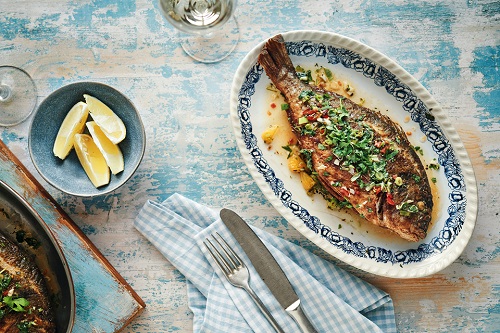Kidney-Friendly Foods from the Puerto Rican Culture

Puerto Rico, “The Island of Enchantment” as it is often called, is a United States territory located in the Caribbean Sea. The island has beautiful beaches, mountains, great year-round weather, friendly people and amazing food! It is easy to see how this island can be so charming.
Puerto Rican Food
Puerto Rican food is mainly a delicious blend of Spanish, African and Taíno Indian cuisine. However, centuries ago many cultures from around the world shaped Puerto Rican food. Puerto Rican food has also been influenced by American cooking through the country’s connection to the United States.
Puerto Rican food is often called “cocina Criolla,” which means “Creole cuisine.” The food is flavored with lots of seasoning and spices. Beware—some recipes are high in calories, carbohydrates, fat, salt and sugar. Many deep fried treats are found in Puerto Rican cooking as well. Some commonly eaten foods are rice, beans, meat, seafood, fruits, plantains and root vegetables.
For people with chronic kidney disease (CKD), some of these Puerto Rican foods are not considered kidney-friendly. However, a person with CKD can work with their dietitian to find a diet plan that can include many of the delicious foods found in Puerto Rican culture.
Puerto Rican Kidney Diet Tips
Rice and beans are staple foods in Puerto Rican culture. Rice is part of a kidney-friendly diet, while beans, if eaten in large amounts, will add up in phosphorus and potassium. The good news is if beans are consumed in small quantities, they can be part of a kidney diet. Your dietitian can help you find the correct portion size of beans for your diet. Check out this recipe from DaVita.com for Arroz con Gandules (Rice with Pigeon Peas), which is a kidney-friendly version of traditional Puerto Rican rice and beans.
Meats and seafood can be enjoyed as part of the kidney diet. Some traditional Puerto Rican meat dishes are roasted pork, pork chops, chicken with rice, steak with onions, and stewed chicken or beef. However, some traditional dishes that are meat- and seafood-based are fried and high in salt. Ask your dietitian for the amount of protein you should consume for your stage of CKD and choose those fried foods less often.
Puerto Rican food uses seasonings and spices to give the food lots of big flavor. To cut down on salt, it is recommended to use no-salt seasoning and spices. In addition, a vegetable- and herb-based seasoning called “sofrito” can also be used to give food some big flavor. Puerto Rican and other Latin American cultures have many different versions for “sofrito.” Use this DaVita Sofrito recipe as an inspiration to make your own “sofrito” using herbs and low-potassium vegetables.
Plantains and roots vegetables are staple foods in Puerto Rican culture. Unfortunately, may of these vegetables are high in potassium. It is possible to include small amounts in recipes modified for the kidney diet. To ensure that your diet is kidney-friendly, stick to the low-potassium fruits and vegetables. Enjoy apples, cherries, pineapples, carrots, peppers, garlic and onions, to name a few. Ask your dietitian about more low-potassium fruits and vegetables that are found in Puerto Rican culture.
Lastly, Puerto Rican culture offers tasty drinks and desserts. But, beware. Some of these items are high in calories, fat, phosphorus, potassium and sugar. Some popular drinks contain alcohol, milk products, soda with added phosphorus, and high-potassium fruits like coconut and papaya. Also, many desserts contain cheese, milk products and high-potassium fruits like coconut and guava. Substitutes like low-calorie sweetener, almond or rice milk, and phosphate-free soda are great to make these drinks more kidney-friendly. Check with your dietitian to see which drinks and desserts are the best choices and the amount you can consume. Remember, always check with your doctor before consuming alcohol to make sure it is safe.
Enjoy the Foods of Puerto Rico!
It is with great joy to say you can eat many of the delicious foods of Puerto Rico and still eat kidney-friendly. So, “buen provecho!”, or “Enjoy your meal!”, as the popular saying in Puerto Rican culture goes, and reach out to your dietitian for more information.
References
- Wagenheim, O. J. , Wagenheim, K., & Mathews, T. G. (2021, September 11). Puerto Rico. Encyclopedia Britannica. Retrieved September 16, 2021, from https://www.britannica.com/place/Puerto-Rico
- Ortíz Cuadra, C. M. (2013). Eating Puerto Rico: A history of food, culture, and identity. The University of North Carolina Press.
- El Boricua. (n.d.). History of Puerto Rican Food. http://www.elboricua.com/food_history.html
- Discover Puerto Rico. Puerto Rico Travel Guide. https://www.discoverpuertorico.com
- Gordon, B. (2018, January 21). Puerto Rican Favorites Made Healthy. Eat Right Academy of Nutrition and Dietetics. Retrieved September 16, 2021, from https://www.eatright.org/food/planning-and-prep/snack-and-meal-ideas/puerto-rican-favorites-made-healthy
- Puerto Rico. (n.d.). Traditional Cuisine – Puerto Rico. https://puertoricocuisine.weebly.com/traditional-cuisine.html
Additional Kidney Diet Resources
Visit DaVita.com and explore these diet and nutrition resources:
- DaVita Food Analyzer
- DaVita Dining Out Guides
- Today’s Kidney Diet Cookbooks
- DaVita Kidney-Friendly Recipes
- Diet and Nutrition Articles
- Diet and Nutrition Videos
- Kidney Smart® Virtual Classes
This article is for informational purposes only and is not a substitute for medical advice or treatment. Consult your physician and dietitian regarding your specific diagnosis, treatment, diet and health questions.

Recent Comments